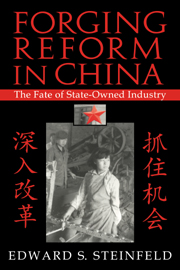Book contents
- Frontmatter
- Contents
- List of Tables and Figures
- Preface
- 1 Introduction: China's Ailing State Enterprises
- Part I Conceptual Approaches to Postsocialist Enterprise Reform
- Part II Enterprise Case Studies: The Commanding Heights in Transition
- Part III Reassessing Chinese Patterns of Economic Development
- 7 Extending the Argument: Budget Constraints and Patterns of Growth in China
- 8 Conclusion
- Notes
- Bibliography
- Index
7 - Extending the Argument: Budget Constraints and Patterns of Growth in China
Published online by Cambridge University Press: 12 January 2010
- Frontmatter
- Contents
- List of Tables and Figures
- Preface
- 1 Introduction: China's Ailing State Enterprises
- Part I Conceptual Approaches to Postsocialist Enterprise Reform
- Part II Enterprise Case Studies: The Commanding Heights in Transition
- Part III Reassessing Chinese Patterns of Economic Development
- 7 Extending the Argument: Budget Constraints and Patterns of Growth in China
- 8 Conclusion
- Notes
- Bibliography
- Index
Summary
IN previous chapters, a constraints-based approach – the nested problems dynamic – was used to explain the particular problem of urban SOE restructuring. In this chapter, we will explore the broader implications of the nested problems dynamic. What can the constraints-based approach tell us about reform beyond the SOE sector? Can the same concepts used to illuminate patterns of urban industrial stagnation also help us understand the phenomenal growth of Chinese rural industry? More broadly, to what extent can a constraints-based approach change our perspective on the overall drivers of growth in postcommand economies? How might our sense of the “appropriate” package of reform policies to adopt change as a result?
TRADITIONAL APPROACHES TO CHINESE REFORM
Like China itself, Western sinology over the past fifteen years has undergone an extraordinary transformation. Long-held perspectives have given way to novel approaches, approaches themselves made possible by unprecedented research opportunities. China's “opening” to the West, although focused mainly on foreign trade and business, has certainly had its academic research component as well. Scholars both within China and abroad have moved aggressively to grasp these new opportunities and to develop new modes for understanding an ever-changing social, political, and economic landscape.
Nevertheless, for all its variety and creativity, recent work on China has been rather circumscribed – somewhat confined within narrow intellectual parameters. Despite their differences and disagreements, scholars of reform generally speak the same language of “property rights,” “decentralization,” “liberalization,” and “autonomy.”
- Type
- Chapter
- Information
- Forging Reform in ChinaThe Fate of State-Owned Industry, pp. 227 - 248Publisher: Cambridge University PressPrint publication year: 1998



